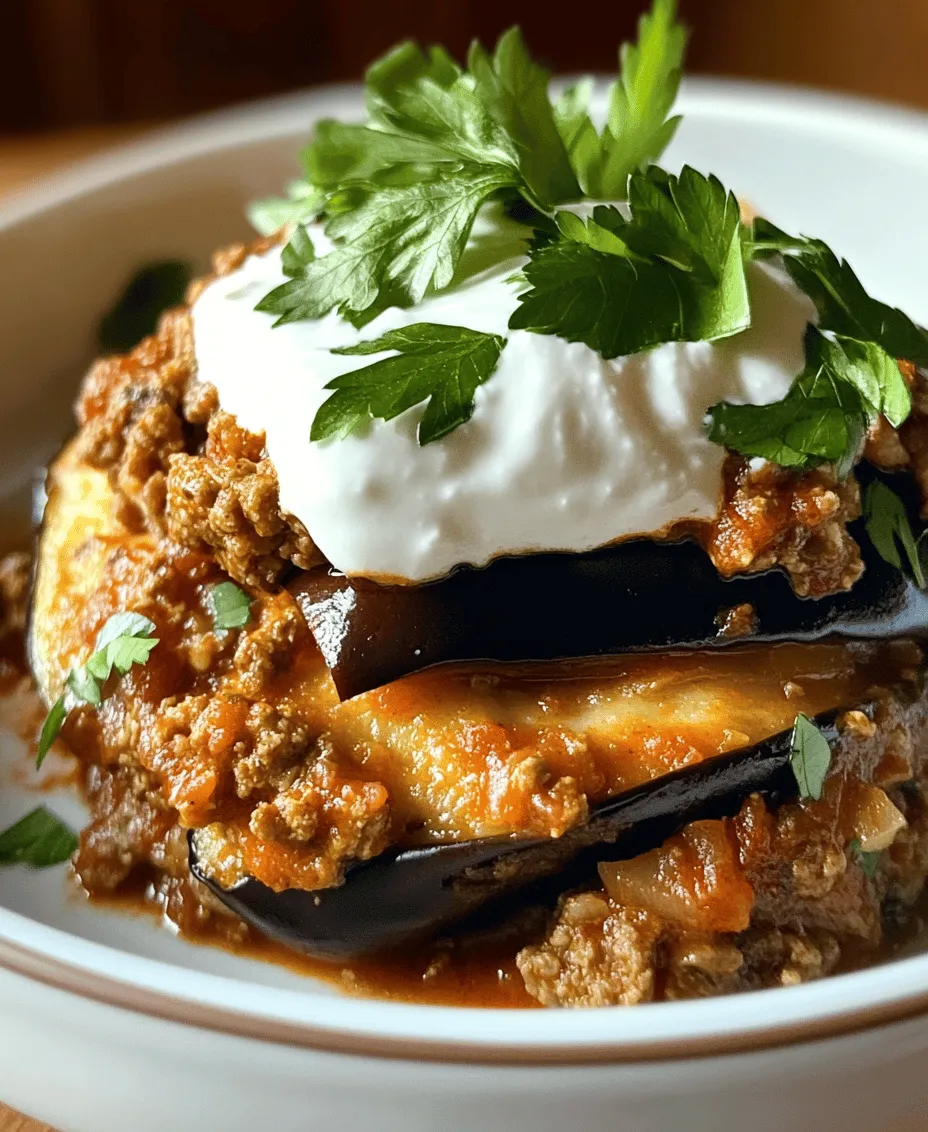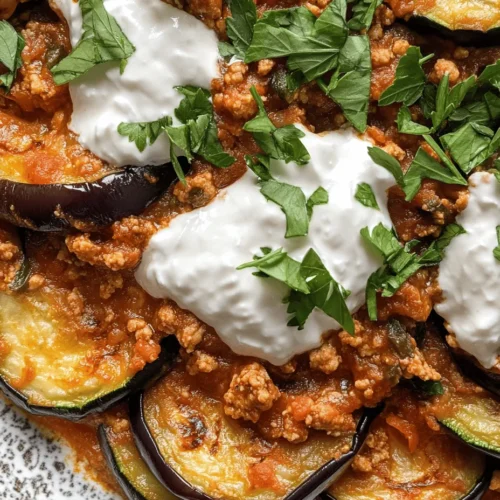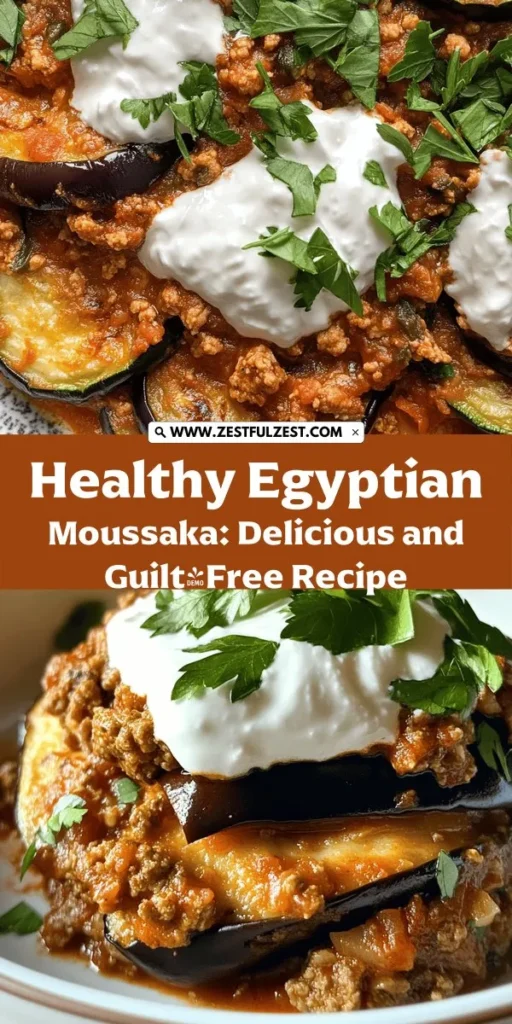Introduction
Moussaka is a beloved dish that resonates deeply within the culinary landscape of various Mediterranean countries, but its roots are particularly cherished in Egyptian cuisine. Traditionally, Moussaka features layers of eggplant, ground meat, and a rich béchamel sauce, creating a comforting and indulgent meal that delights the senses. However, as health consciousness grows, the need for healthier adaptations of traditional recipes has become increasingly important. This shift not only allows us to enjoy our favorite dishes without compromising our health goals but also preserves the essence of the original flavors.
Introducing the Heartfelt Healthier Egyptian Moussaka: a delightful take on the classic recipe that maintains its rich flavors while incorporating nutritious ingredients. This healthier version swaps out high-calorie components for lighter alternatives, making it a guilt-free option for anyone looking to indulge in a hearty meal without sacrificing their well-being. Utilizing fresh vegetables, lean protein, and a creamy yogurt topping, this recipe promises to deliver a satisfying dish that nourishes both body and soul.
Understanding the Ingredients
To create the Heartfelt Healthier Egyptian Moussaka, it’s essential to understand the key ingredients that contribute to its flavor, texture, and health benefits. Each component plays a vital role in not only enhancing the dish but also providing nutritional value, making this recipe a wholesome choice.
Eggplants and Their Health Benefits
Eggplants are the star ingredient in traditional Moussaka, and for good reason. Rich in antioxidants, particularly nasunin found in the skin, eggplants help combat oxidative stress in the body. They are also a good source of fiber, which aids digestion and promotes a feeling of fullness. Additionally, eggplants are low in calories, making them an excellent choice for those looking to maintain a healthy weight.
In this recipe, eggplants are roasted to enhance their natural flavors and achieve a tender texture, which serves as a perfect base for layering with the other ingredients.
Zucchini as a Low-Calorie Vegetable
Zucchini is another essential component in our healthier Moussaka. This versatile vegetable not only adds moisture and flavor but also contributes significantly to the nutritional profile of the dish. Zucchini is low in calories and high in water content, making it an ideal ingredient for those looking to reduce calorie intake while still enjoying a filling meal.
Furthermore, zucchini is rich in vitamins A and C, both of which are crucial for maintaining healthy skin, vision, and immune function. Its mild flavor allows it to blend seamlessly with the robust spices and other ingredients in the Moussaka, enhancing the overall taste without overpowering it.
Lean Ground Turkey or Chicken as a Healthier Protein Option
Traditionally, Moussaka is made with ground beef or lamb, which can be high in fat and calories. In this healthier version, we use lean ground turkey or chicken, which provides a leaner source of protein. This substitution significantly reduces the overall fat content of the dish while still delivering a hearty and satisfying flavor.
Lean ground turkey and chicken are excellent sources of protein, essential for building and repairing tissues in the body. They are also lower in saturated fat compared to red meats, making them a heart-healthy option that aligns with our goal of creating a nutritious meal.
The Role of Spices in Flavor and Health
No Moussaka is complete without the warm and aromatic spices that define its flavor profile. In our Heartfelt Healthier Egyptian Moussaka, we use a blend of cumin, smoked paprika, cinnamon, and oregano to elevate the dish’s taste and nutritional value.
– Cumin adds a warm, earthy flavor and is known for its digestive properties. It may also help with weight management and has anti-inflammatory effects.
– Smoked paprika brings a subtle smokiness and depth to the dish, and it is rich in antioxidants that can support overall health.
– Cinnamon not only adds a hint of sweetness but also has been linked to improved blood sugar control and heart health.
– Oregano is packed with antioxidants and has antibacterial properties, making it a great addition to boost the dish’s health benefits.
These spices not only enhance the flavor of the Moussaka but also contribute to its health-enhancing properties.
Discussion on the Use of Greek Yogurt
One of the key elements of traditional Moussaka is the béchamel sauce, which typically consists of butter, flour, and milk. In our healthier adaptation, we replace this rich sauce with Greek yogurt, creating a creamy topping that is both delicious and nutritious.
Greek yogurt is high in protein and lower in fat than traditional sauces, making it an excellent alternative. It also contains probiotics that support gut health and improve digestion. When combined with a bit of seasoning, Greek yogurt adds a tangy flavor that complements the richness of the roasted vegetables and meat.
Preparation Steps for Heartfelt Healthier Egyptian Moussaka
Now that we’ve explored the essential ingredients and their benefits, let’s dive into the preparation steps for creating this Heartfelt Healthier Egyptian Moussaka. This section will guide you through the process, ensuring that each layer of the dish is packed with flavor and nutrition.
Preparing the Vegetables
The first step in making our Heartfelt Healthier Egyptian Moussaka is preparing the vegetables. Proper preparation is crucial for achieving the perfect texture and flavor balance in the dish.
1. Roasting Eggplants
– Start by preheating your oven to 425°F (220°C).
– Slice the eggplants into ½-inch thick rounds. If you prefer, you can also cut them into strips or cubes.
– Lay the eggplant slices on a baking sheet lined with parchment paper. Sprinkle with salt and let them sit for about 15-20 minutes to draw out moisture. This step helps reduce bitterness and prevents the eggplants from becoming too soggy during cooking.
– After 20 minutes, rinse the eggplant slices under cold water to remove excess salt and pat them dry with a paper towel.
– Drizzle the eggplant slices with olive oil and toss to coat. Arrange them in a single layer on the baking sheet and roast for 20-25 minutes, flipping halfway through, until they are golden brown and tender.
2. Roasting Zucchini
– While the eggplants are roasting, prepare the zucchini. Slice the zucchini into rounds or half-moons, approximately ½ inch thick.
– Place the zucchini on a separate baking sheet, drizzle with olive oil, and season with salt and pepper. Toss to coat evenly.
– Roast the zucchini in the same oven for about 15-20 minutes, until they are tender and slightly caramelized.
Roasting the vegetables not only intensifies their flavors but also adds a delightful texture to the Moussaka, creating a satisfying contrast to the creamy topping.
Cooking the Meat
Next, we’ll move on to cooking the meat, which will serve as the savory layer in our Moussaka.
1. Sautéing Onions and Garlic
– In a large skillet over medium heat, add a tablespoon of olive oil. Once heated, add finely chopped onions and sauté until translucent, about 5 minutes.
– Add minced garlic and cook for an additional 1-2 minutes, until fragrant. This aromatic base will infuse the meat with incredible flavor.
2. Cooking Ground Turkey or Chicken
– Add the lean ground turkey or chicken to the skillet with the sautéed onions and garlic. Use a wooden spoon to break the meat apart as it cooks.
– Season the meat with salt, pepper, cumin, smoked paprika, and a pinch of cinnamon. Cook until the meat is browned and fully cooked through, about 7-10 minutes.
– Stir occasionally to ensure even cooking and to combine the spices thoroughly with the meat. This step is essential for developing the rich flavor profile that defines Moussaka.
Making the Sauce
While the meat is cooking, we can prepare the sauce that will bring all the layers together.
1. Combining Ingredients for the Sauce
– In a separate saucepan, combine diced tomatoes (canned or fresh), a tablespoon of tomato paste, a splash of water, and a pinch of salt and pepper. Stir to combine.
– Allow the sauce to simmer over low heat for about 10-15 minutes. This will allow the flavors to meld together and create a rich, savory sauce that will complement the other layers.
2. Adjusting Seasoning
– Taste the sauce as it simmers and adjust the seasoning as needed. This is your opportunity to enhance the flavors, so feel free to add more spices or salt according to your preference.
Creating the Creamy Yogurt Topping
As the sauce simmers, it’s time to prepare the creamy yogurt topping that will elevate our Heartfelt Healthier Egyptian Moussaka.
1. Mixing the Yogurt Topping
– In a small mixing bowl, combine Greek yogurt with an egg. This will help the yogurt to firm up as it bakes and create a luscious, creamy layer on top.
– Season the mixture with a pinch of salt, pepper, and dried oregano for added flavor. Mix until smooth and well incorporated.
With the vegetables roasted, the meat cooked, the sauce simmered, and the yogurt topping prepared, you are well on your way to assembling the Heartfelt Healthier Egyptian Moussaka. This dish is not only a celebration of flavors but also a commitment to healthier eating without sacrificing the joy of a hearty meal.
Stay tuned for the next part of this recipe, where we’ll delve into the assembly and baking process that will bring this delightful dish to life.

Step-by-Step Guide on Preparing the Yogurt and Egg Mixture
To achieve the creamy, rich topping that defines a traditional moussaka while keeping it healthier, we will prepare a yogurt and egg mixture. This step is crucial as it adds a delightful creaminess without the extra calories that come from heavy cream or bechamel sauce.
Ingredients for the Yogurt and Egg Mixture:
– 1 cup of Greek yogurt (non-fat or low-fat)
– 2 large eggs
– 1 teaspoon of salt
– 1/2 teaspoon of black pepper
– 1 teaspoon of dried oregano (optional)
Instructions:
1. In a mixing bowl, combine the Greek yogurt and eggs. Use a whisk or fork to blend them together until smooth and creamy.
2. Season the mixture with salt, black pepper, and dried oregano if desired. This seasoning enhances the flavor and gives it a Mediterranean touch.
3. Whisk the ingredients together again until everything is well incorporated. Set the mixture aside while you layer the moussaka.
This yogurt and egg topping not only adds creaminess but also brings the benefits of protein and probiotics from the Greek yogurt, which contributes to a healthier dish overall.
Assembling the Moussaka
Once all your components are prepared—the sautéed vegetables, seasoned meat mixture, and yogurt topping—it’s time to assemble your Heartfelt Healthier Egyptian Moussaka. Proper layering is essential for both flavor and presentation.
Instructions for Layering:
1. Preheat your oven to 350°F (175°C).
2. In a large baking dish (approximately 9×13 inches), start by spreading a layer of the meat mixture at the bottom. Make sure to cover the entire base evenly.
3. Next, add a layer of the sautéed eggplant and zucchini, ensuring that the vegetables cover the meat mixture completely.
4. Repeat the layering process, beginning with another layer of meat, followed by more vegetables. Aim for at least two layers of each, but you can adjust based on your preference and the depth of your dish.
5. Once you have your layers set, pour the yogurt and egg mixture evenly over the top layer of vegetables. Use a spatula to spread it gently for an even distribution. This topping will create a beautiful golden crust during baking.
Importance of Layering:
Layering enhances the overall flavor profile of the moussaka, allowing each ingredient to contribute to the dish without overpowering one another. Additionally, a well-layered moussaka presents beautifully when sliced, showcasing the vibrant colors of the vegetables and the creamy topping.
Baking Process
With your moussaka assembled, it’s time to bake it to perfection.
Instructions for Baking:
1. Place the assembled moussaka in the preheated oven and bake for approximately 45-55 minutes.
2. The key indicator for doneness is the top layer of yogurt and egg mixture. It should be set and golden brown. If the top browns too quickly, you can cover it loosely with aluminum foil during the last 15-20 minutes of baking.
3. To check if the moussaka is done, gently shake the dish; if the center is slightly jiggly but not liquid, it is ready to come out.
Visual Cues for Doneness:
Look for a golden-brown crust on top and a firm structure throughout the dish. The edges should be bubbling slightly, indicating that the ingredients are heated through.
Serving Suggestions
Once baked, allow your moussaka to cool for about 10-15 minutes before serving. This resting period helps the layers set, making it easier to cut and serve.
Presentation Ideas:
– Slice the moussaka into squares and serve on individual plates.
– Garnish with fresh parsley or a sprinkle of paprika for added color.
– Offer a wedge of lemon on the side for a zesty contrast.
Suggested Side Dishes:
To complement your Heartfelt Healthier Egyptian Moussaka, consider serving:
– A light Greek salad with cucumbers, tomatoes, olives, and feta cheese for a refreshing contrast.
– Whole grain bread or pita to soak up the delicious flavors of the moussaka.
– Steamed or roasted vegetables for added fiber and nutrients.
Nutritional Benefits of This Recipe
This Heartfelt Healthier Egyptian Moussaka not only satisfies your taste buds but also provides a wealth of nutritional benefits.
Nutritional Breakdown (per serving):
– Calories: Approximately 300-350, depending on portions and specific ingredients used.
– Protein: The lean ground meat contributes a significant amount of protein, essential for muscle repair and overall health.
– Fiber and Vitamins: The eggplant, zucchini, and tomatoes are rich in dietary fiber, vitamins A and C, and other essential nutrients. Fiber aids in digestion and helps maintain a healthy weight.
– Health Benefits of Greek Yogurt: Greek yogurt is a great source of probiotics, which support gut health. It also provides calcium and protein, making it a nutritious alternative to traditional creamy sauces.
Comparison with Traditional Moussaka:
Compared to traditional moussaka, which can contain upwards of 600-800 calories per serving due to heavy sauces, this healthier version significantly reduces both calories and fat content. The use of Greek yogurt instead of cream not only cuts calories but also adds a healthy dose of protein, making this dish a heart-friendly option.
Conclusion
The Heartfelt Healthier Egyptian Moussaka stands out as a delightful and nutritious alternative to the classic version. With its layered flavors, creamy yogurt topping, and wholesome ingredients, this dish is sure to please both your palate and your health goals.
We encourage you to try this recipe and enjoy the satisfaction of creating a healthier take on a beloved classic. By incorporating healthy cooking methods and ingredients into your meals, you can indulge in comfort food without compromising on nutrition. Embrace this recipe as a stepping stone to a more balanced diet, proving that delicious meals can also be nutritious. Enjoy your culinary adventure with this Heartfelt Healthier Egyptian Moussaka and share it with family and friends for a wholesome dining experience.



